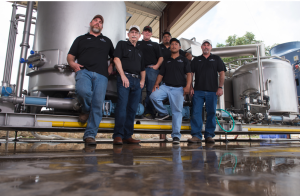
The Incredible “Flash” Machine: Dr. Bob Makes the Case for Better Texas Wine with Flash Détente
Newsom Grape Day always brings out something new or of timely interesting. This year’s Grape Day, held in the Newsom Vineyards “Barnery” in late-April, did not disappoint. While Bob Young, owner of Bending Branch Winery in Comfort, has given demonstrations and tastings on what flash deténte can do to wine, the presentation he gave at Newsom Grape Day and the tasting that followed was the most detailed and convincing yet. It was done with the thoroughness of a medical doctor (which he is) and the persuasiveness of a courtroom lawyer. See link at bottom of page for PDF of Dr. Young’s presentation.
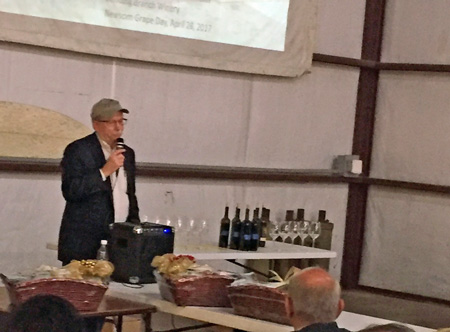
For a little background, The “dash of flash” Dr. Young refers to is produced by Bending Branch Winery’s grape processing (flash deténte) unit (also called a Biothermal Cooler, or BTC) that uses heat, vacuum and flash cooling to completely macerate the grape skins to extract their hidden tannins, flavors and exciting aromatic compounds. When the unit arrived at Bending Branch, it was only one of five BTC units in the United States and the only one not in California. Now, there are 11 units in the USA and Young’s flasher is only one of three not California.
Dr. Young schooled the massive Newsom Grape Day audience on tannins (that create astringency, complexity and promote ageability), anthocyanins (red color compounds) and varietal fruit flavor compounds (all the yummy stuff) in red wine grapes. He indicated that 20-38% of these substances are in the grape skins, and they are precisely what you want in your wine and pay good money to get.
The trouble is, these compounds are hard to extract. For centuries, winemakers have crushed and macerated grapes and soaked them for extended periods in an effort to achieve deep extraction. In modern winemaking, they even add chemical enzymes in this same effort. But, using these now convention techniques, winemakers are limited to getting only a limited portion of these compounds out of the grape skins and into their wines. Additionally, with the good, they often get the bad (harsh tannins from seeds and stems).
A little European secret is that flash deténte has been around for many years but is rarely talked about, usually done in the hidden bowels of the wineries, or in the dark of night after visitors leave for the day the curtain drops and the flash unit is put into action.
For the past few harvests, Bending Branch Winery has used their flash unit and offers it to others, too. The flash process involves rapid heating of the “grape must” followed by rapid cooling while under vacuum. As a result, grape skin cells and vacuoles rupture (literally explode) releasing anthocyanins and tannins. However, seed tannins (that are often bitter) are not extracted. High color and high nutrient must is produced ready for fermentation.
Many of the unwanted compounds are concentrated in the flash water and removed. These unwanted flavors, aromas and bacteria (like pyrazines, acetobacter, and brettanomyces to name a few) are removed and varietal aromas and flavors are concentrated in the grape must and will be available in the resultant wine. Equally amazing, Brix (a measure of sugar content in the must) increases from flashing about 1 to over 5 units – the equivalent of having riper grapes with which to start. Thus, flashing can be used to help save grape harvests in years when moderate rot has occurred in the vineyard and can be used to deal with under-ripened fruit, or when an excess of rain occurs at harvest.
The real “punch line” with flash deténte as Dr. Young later added, “Flash adds roughly a dollar per bottle to the cost of the wine. In general, the quality of the flashed wine should command a significant increase in price, more than covering the flashing cost. In some cases, it might be the difference in having wine to sell versus not having wine to sell. It also allows for purchasing lower priced fruit and still making a very good wine. There are lots of options.”
Dr. Young showed that experience from 1995 data with flash in other regions Rhone grape varieties indicated impressive numbers: increase of about 20-22% in tannins and 26-30% increase in anthocyanins in the must. However, prior to his study, there were no data available for the benefits of flash deténte on Texas grapes.
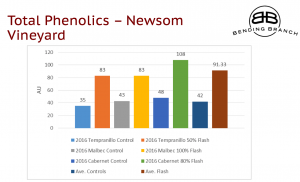
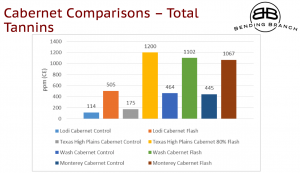
The figure shown above shows in graphic detail the increase in total phenolics* in the grape must after flash deténte versus the baseline (without it) for several grape varieties harvested from the Newsom Vineyard in 2016. Also shown, is a comparison of extracted tannins in Newsom Cabernet versus cabs from other regions with other regions after flashing. See who’s on top? Dr. Young also presented a massive amount of data including data on Reddy Vineyards grapes (see PDF link at bottom of blog).
*Total phenolics include phenolic acids, stilbenoids, flavonols, dihydroflavonols, anthocyanins, flavanol monomers (catechins) and flavanol polymers (proanthocyanidins). This large group of natural phenols can be broadly separated into two categories, flavonoids, and non-flavonoids. Flavonoids include the anthocyanins and tannins which contribute to the color and mouthfeel of the wine.
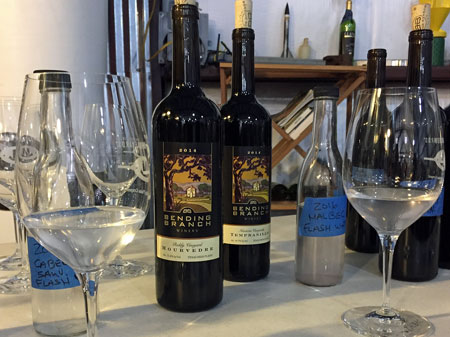
After Dr. Young’s presentation, we were invited to taste two Bending Branch cryo-macerate wines: their 2014 Newsom Vineyards Tempranillo and 2014 Reddy Vineyards Mourvedre. For these wines, Dr. Young actually froze the grapes in the cryo-treatment to get better tannin, color and aromatic extraction. Also available for tasting were flashed Newsom Cabernet and Reddy Tannat from the 2016 vintage that had a very wet harvest period. This tasting also came with a sniff of the flash water containing bad stuff removed from these wines. The most noticeable aspects of the two flashed wines were their dark inky color and their near-overwhelming aromatics.
Based on research he performed, Dr. Young concluded, “Flash extraction can produce a ‘greater expression of place’. By this I mean, more of the grapes contents are available in the grape must for winemaking. Negative components can be removed (e.g. mold, barnyard, etc.). This technology can translate less than optimal crops into better wines (e.g. low Brix, low maturity, over-cropped conditions, moderate rot infection, excessive vegetative conditions). Flash may even expand the life span of a vineyard due to enhanced extraction, and produce better wines from grape varieties not currently matched to Texas climate and growing conditions (e.g. Pinot Noir, Zinfandel, others).”
Dr. Young even threw out another possible use of flash deténte that hits closer to home for me on the Texas Gulf Coast and in east Texas. Here, the majority of the wine grapes are hybrids like Black Spanish (Lenoir) and Blanc Du Bois. He posed the following questions:
- “Will the foxy flavor of Black Spanish come out in flash water and make a ‘really good Black Spanish’ red table wine?
- Can Blanc du Bois be improved by flash?
- Could other hybrids benefit from flash?”
There is a lot to consider here. Dr. Young is a curious and thorough guy. He has made an investment of time and money to bring flash deténte to Texas. He is sharing the capability with others looking to keep Texas on the cutting edge of fermentation science in the United States and the world.
The added value of the flashed wine in terms of its enhanced characteristics could be $5 to $10 in bottle price, and consumers should note that it will likely be worth every penny of it. Alternatively, at a fixed bottle price say in the sub-$20 market, you can get a really nice palatable wine. If you are interested in trying it, give a try of Bending Branch Red available at the Cooking Connections at many HEB store around the state (See below).
Interested? For more information, contact Dr. Robert Young, owner, Bending Branch Winery, 142 Lindner Branch Rd, Comfort, TX 78013, tele: (830) 995-2948, or stop by to visit with him in Comfort Texas. www.bendingbranchwinery.com.
Click here for a PDF version of Dr. Young’s flash deténte presentation.
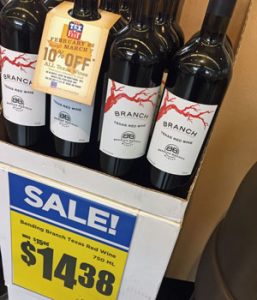

Great wine used to be made in the vineyard; now is it made in the extractor? The key is right there: “This technology can translate less than optimal crops into better wines.” Why are the crops less than optimal? Why not get it right in the vineyard in the first place?